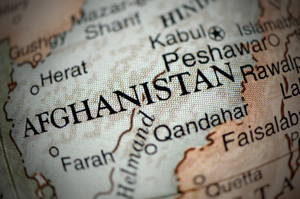
Survival odds: are all soldiers equal?

Being killed in a peacekeeping mission apparently depends on your nationality, at least if you're a soldier in the Spanish army. On the 1st of February 2010 the Colombian soldier John Felipe Romero serving in the Spanish army was killed in a terrorist attack in Afghanistan. It was then made public that so far 43% of the Spanish troops killed in attacks by local forces in Afghanistan and Lebanon have been foreigners. This is in striking contrast to the fact that foreign nationals make up only 7% of the Spanish army as a whole. The two figures 43% and 7% have been repeatedly highlighted in the Spanish newspapers since Romero's death.
Assuming that the probability of being exposed to an attack is independent of nationality, the gap between the figures is surprising. A possible explanation is that the proportion of foreigners in military missions abroad is far greater than in the army as a whole. Perhaps foreign nationals like to sign up to risky operative units because they offer higher salaries, as has been suggested by the General Director of Recruitment of the Spanish army in an interview to El País. Or maybe it is because military work in a conflict zone is an unpopular job preferably left to immigrants, as was suggested by the Spanish soldier Rubén López on the same page in the same newspaper.
But in the absence of further information, what can a foreign national about to enter the Spanish army infer from the published figures? What are the chances of dying on a mission in Afghanistan or Lebanon for a soldier from, say, Madrid, Colombia, compared to a soldier from Madrid, Spain?
Recalling high-school mathematics lessons, the soldier could proceed as follows. Write $N$ for the total number of soldiers in the Spanish army. Since 7 out of 100 soldiers are foreigners, the total number of foreigners in the army is $0.07N$. Now write $d$ for the number of soldiers that have been killed on a mission, irrespective of their origin. Then $0.43d$ is the number of foreigners among the dead - this corresponds to the disasterous 43\%. Putting this together shows that the proportion of foreigners killed on a mission is $$\frac{0.43d}{0.07N}=6.14\frac{d}{N}.$$ That is, the proportion of dead among the foreigners is over six times higher than the proportion $d/N$ of dead within the whole army.
To compare this with the proportion for the native population, notice that $100\%-7\%=93\%$ of the army are Spanish nationals, and that $100\%-43\%=57\%$ of the dead are Spanish. By the same reasoning as above, we get $$\frac{0.57d}{0.93N}=0.61\frac{d}{N},$$ for the proportion of Spaniards killed on a mission. That is, the proportion of Spaniards being killed is just 61\% of the overall proportion of dead soldiers.
How does the proportion of dead among foreigners compare to that for Spanish nationals? To find out, we take the quotient of the two: $$\frac{6.14\frac{d}{N}}{0.61\frac{d}{N}}=10.06.$$ So the proportion of dead among the foreigners is around ten times higher than the proportion of dead among Spaniards.
What does all this tell our prospective soldier about his or her prospects in the Spanish army? If these proportions, or frequencies, are interpreted as probabilities, that is if we take the current situation as a sign of things to come, then our result says that the probability of our foreign soldier dying on a mission is ten times the probability of his Spanish colleague dying on a mission.
In fact, our calculation above is an application of the celebrated Bayes' theorem (published in 1764). Write $P(D)$ for the (unknown) probability of a soldier dying, irrespective of nationality, and $P(F)=0.07$ for the probability of a soldier picked at random being a foreign national. Then the 43\% figure corresponds to the conditional probability $P(F|D)$ of a soldier being foreign given that he or she has been killed - we have $P(F|D)=0.43.$
In accordance with our calculation above, Bayes' theorem says that $$P(D| F)=\frac{P(F|D) P(D)}{P(F)} = \frac{0.43 P(D)}{0.07} = 6.14P(D),$$ where $P(D|F)$ is the conditional probability of dying given that you are foreign. Writing $P(notF)$ for the probability of being Spanish and applying Bayes' theorem again, we get the corresponding result $$P(D| notF)=\frac{P(notF|D) P(D)}{P(notF)} = \frac{0.57 P(D)}{0.93} = 0.61P(D).$$

Our calculations are valid for any immigrant soldier, whether on a mission or not, comparing him or herself to any Spanish soldier. But what about a foreign soldier already on a mission, comparing him or herself to fellow Spanish soldiers also on a mission? Our results remain valid if the troops that are sent abroad preserve the distribution of foreigners in the whole army — that is, if 7% of troops abroad are foreigners. In this case our immigrant soldier on the mission is ten times more likely to be killed than a Spaniard on a mission. This enormous difference would have to be explained by local matters related to missions abroad. However, it may be that the percentage is not preserved, and that the difference in odds is explained by a similar difference in the probabilities of being sent abroad. Unfortunately, the percentage of immigrants in missions has not been published so far, so we cannot say which of the two it is.
A revolutionary contribution of mathematics to human culture was the recognition that logic can make reliable quantitative predictions about the unknown future. In a very democratic sense, mathematics offers anyone a mathematical crystal ball to unveil the future from information generated in the past. Our soldier's analysis has revealed the distressing truth that his probability to die in a Spanish mission is ten times higher than that of a Spanish soldier. It seems very unlikely that this fact is mentioned in his contract, or reflected in his salary.
Further reading
If you speak Spanish, you can read coverage of this issue in El País here, here, and here.
Probability theory was born in 1654, in a letter from Blaise Pascal to Pierre de Fermat, as engagingly recounted by Keith Devlin in his book The Unfinished Game: Pascal, Fermat, and the Seventeenth Century Letter that Made the World Modern.
About the author
José-Manuel Rey is Professor of Mathematics at the Universidad Complutense in Madrid.
Comments
Rachel
Anonymous
I don't see any misuse of statistics in the article. First raw data shows that a strong correlation does exist. Then, before interpreting that in terms of probabilities (with due care),
a plausible explanation for causality is offered from statements that appeared in the press. Correlation seems far from being due to chance.